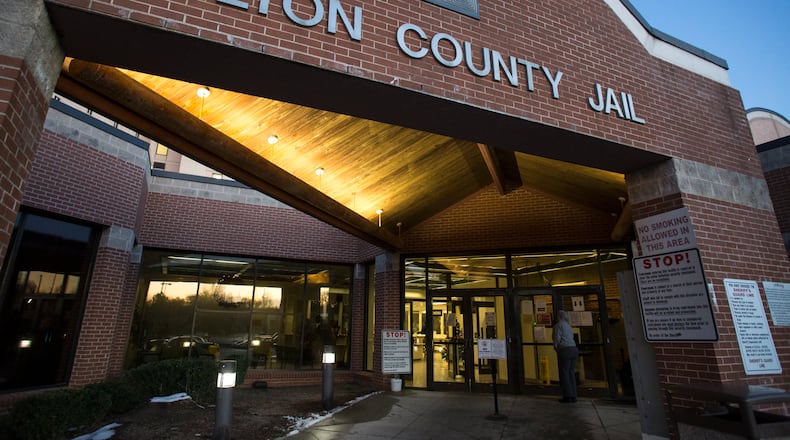A problem that plagued Fulton County’s jail system for years is back: too many inmates.
For more than a decade, Fulton County's main Rice Street jail was under federal court oversight due to overcrowding and other issues. Now, four years after the oversight was lifted, the jail population has again ballooned.
Over the past week, the daily population at the county’s four facilities surpassed 3,000 inmates on several days, said Mark Adger, Fulton County’s chief jailer. The highest count was 3,023 inmates; as of Wednesday, there were 3,009 people in custody in Fulton County.
The total capacity of the county's jails is 3,048, but Adger said the need to separate some inmates and isolate others for mental health, safety or other reasons means that not every bed is usable. Ideally, the jails would be considered full with 2,591 inmates. A court-approved consent decree from 2006 caps the Rice Street population at 2,500, and the other facilities have a maximum capacity of 423.
The average daily population for the system has been above 2,800 since at least January, and was above 2,900 in January, March and May.
“It’s a problem for us,” said Robb Pitts, the Fulton County commission chairman. “It’s a problem we’re going to have to address quickly.”
Sara Totonchi, the executive director of the Southern Center for Human Rights, said she's concerned that inmates will suffer because the population has gotten so high. The center filed the original lawsuit that led to the court oversight.
"The Fulton County Jail has a long history of serious problems exacerbated by overcrowding," Totonchi said. "We have seen time and again that when the jail's population starts to climb, conditions inside deteriorate and safety decreases for both detainees and staff. The county must address this immediately."
Adger said the county manager’s office is investigating the causes, but nothing is being done to reduce the jail population.
Alton Adams, Fulton’s deputy chief operating officer for public safety, declined to comment on any steps the county is taking. A spokesperson for the sheriff’s office sent statistics, but did not respond to requests for an interview.
At Wednesday’s meeting of the board of commissioners, county manager Dick Anderson said the numbers were “truly beyond” what the capacity should be. He said about 180 inmates at the Rice Street jail were sleeping on mattresses on the floor in open areas. With an increase in inmates, Adger said, medical services are being stressed and more inmates are assigned to the floor, because there are no beds available.
“We are in the mode of trying to figure out alternatives for people who are arrested as we speak,” county attorney Patrise Perkins-Hooker said. “It is a critical situation for Fulton County, and it’s only going to get worse depending on the situation at the Atlanta detention center.”
Last month, Atlanta leaders decided to close its jail after a decision to eliminate cash bond requirements for poor and nonviolent offenders led to fewer people being held. But statistics from the Fulton County sheriff's office show inmates from Atlanta make up about a third of the jail's population, and Adger said more people from the city are being held without bond at the county jail on failure-to-appear warrants after missing their original court dates.
"The implications go beyond just the city of Atlanta," Fulton County Commissioner Marvin Arrington said.
Perkins-Hooker said her office was considering asking for an injunction to keep more Atlanta inmates from being delivered to the county. The county could also send inmates to other jails.
In addition to the number of prisoners from Atlanta, Anderson said the courts may be declining to release people on bond because of public pressure after some inmates who were released on bond went on to commit more crimes. He also said the county jail had 380 inmates who had been awaiting trial for more than a year, 142 witnesses who had been transferred to Fulton County for trials but could be returned to other jails, and more than 500 people jailed on misdemeanor charges who could be moved through more quickly.
Reducing the number of inmates at the jail has long been a priority of county leaders. Since 2016, county commissioners have set aside money in the budget to divert people from jail and push backlogged cases through the system more quickly so people who are being held awaiting trial could move on. They expected the average daily population to be below 2,000 inmates as a result of those efforts.
The recent increase undermines years of efforts to improve conditions at the jail. With the court's oversight for 11 years, the county spent more than $1 billion to replace or repair plumbing, the heating and air system, elevators and wiring. The county also replaced the locks on every cell door. At the time the original suit was filed, raw sewage flooded cells, inmates had to sleep on the floor, and faulty locks meant they could wander around the jail at will. In 2015, the oversight was lifted.
In April, the Georgia Advocacy Office filed a suit regarding conditions at the South Fulton Municipal Regional Jail in Union City, which houses female inmates. The suit said mentally ill inmates were being denied necessary health care and were being held in unsanitary conditions.
Devon Orland, the litigation director of the Georgia Advocacy Office, said if the system is overcrowded, people aren’t getting what they need.
“When you get to capacity, resources get stressed,” she said.
About the Author
The Latest
Featured



